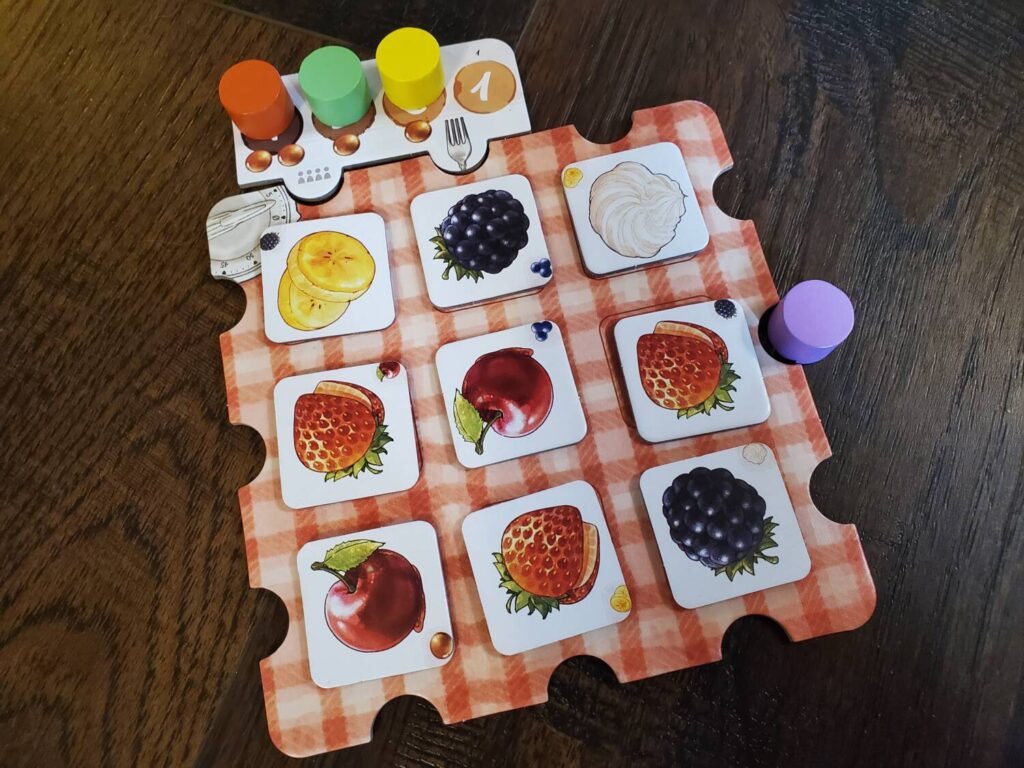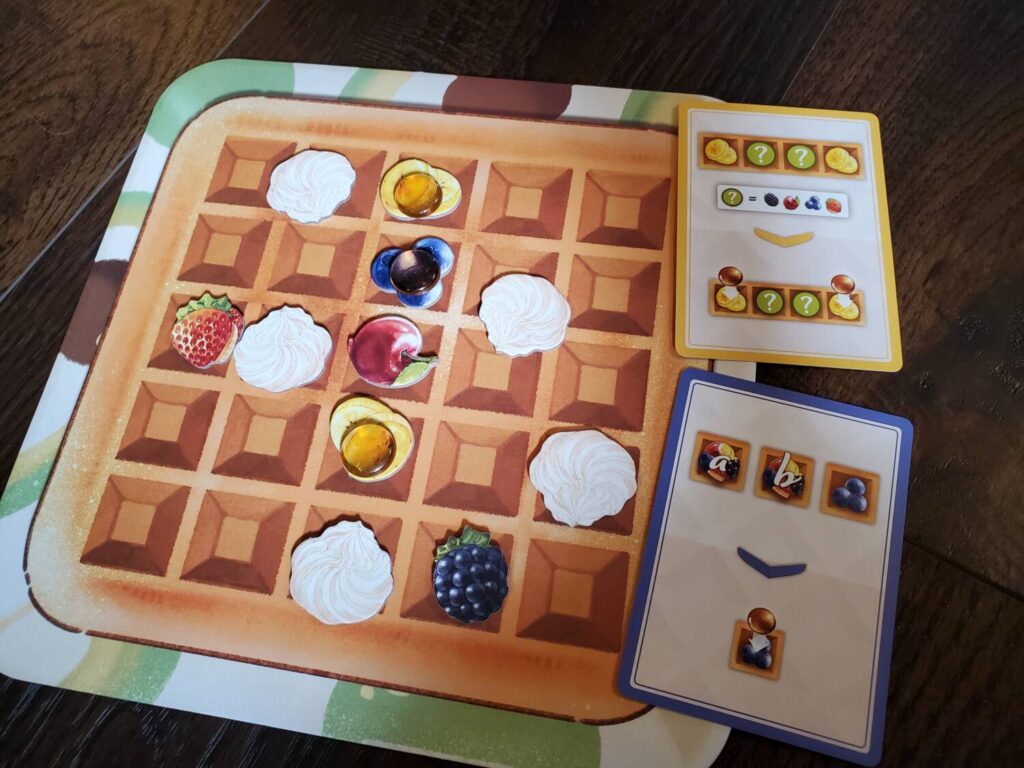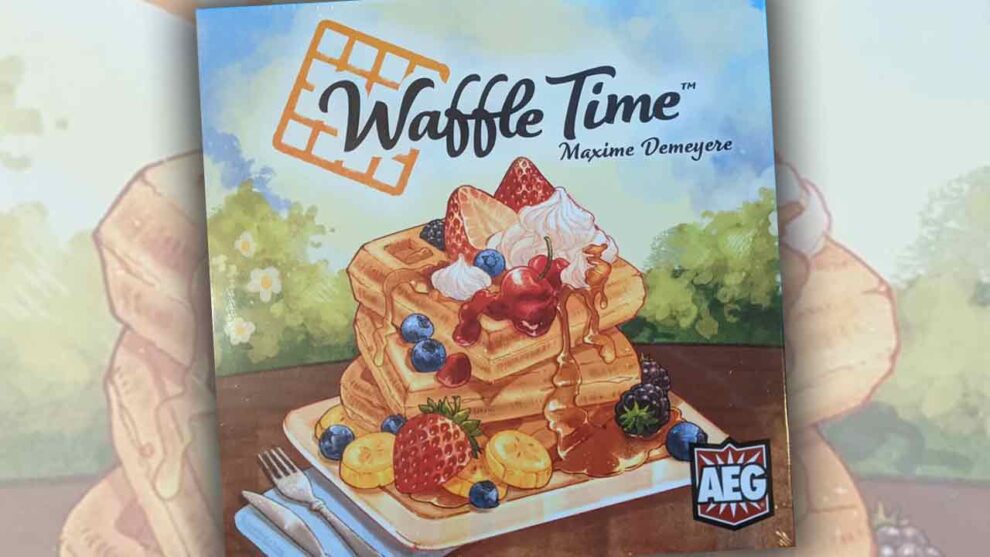Disclosure: Meeple Mountain received a free copy of this product in exchange for an honest, unbiased review. This review is not intended to be an endorsement.
I’m not entirely sure how one becomes a waffle expert. We’ve stayed in hotels—hotels with waffle irons. We even own a little waffle iron that keeps us a mere four minutes from gridded deliciousness (once the egg-white batter is ready and the little green light says the iron is hot, that is) any time we want. Still, I’m no expert.
Waffle Time comes from the creative mind of Maxime Demeyere. He is Belgian. That gives him the upper hand when it comes to waffles (reports suggest the battered delights were born there in 1958). The game is an exercise in meticulously preparing each cup with whipped cream, fruit, and syrup. I can’t say I’ve ever been so careful with a real waffle, but as I’ve already stated, my chops are rather pedestrian.
Waffle Time has all the feel of an abstract with all the appearance of a sweet treat. My kids see the bright and colorful confection and shout until I bring it to the table. I open the box and see the multi-layered spatial puzzle lurking beneath the fruity exterior. Two worlds will collide. Is this a recipe for success?
Blueberry Eggo is a flavor all its own
Each player receives a plated waffle, a 5×5 grid primed for toppings. Randomly dealt cards provide a few dashes of whipped cream and two bits of fruit as a starting configuration for each player. The flipside of the card is a syrup dispenser that receives six glass beads as drops of maple-y goodness.

The game’s motivation is driven by four cards that detail the final scoring aims. The standard card lists four basics: one point for each space with fruit+syrup, three points for cream+fruit+syrup, two points for a pat of butter, and two points for an empty syrup dispenser. Three goal cards provide the additional targets. These include quantities or patterns of fruits and syrup which, once achieved, guarantee the endgame points. The first player to achieve each card receives butter for their waffle.
The mechanism is a quirky little draft board in the center with a 3×3 grid of randomized tiles. Each two-sided tile has a fruit, cream, or syrup. Around the outside, player tokens begin on a turn order tile (that either gives syrup or not based on positioning). A set of notches locks this tile in one location for each of the game’s eight rounds.

Players take turns placing their wooden player marker into any available notch, claiming a cardboard token for the first two bits displayed. So if the first two tiles are a strawberry and a cherry, the player would grab matching tokens from the supply and add them to their waffle in orthogonally adjacent spaces.
The aim of placement is determined by five other pattern cards. Each fruit receives syrup if, at any time, a pattern is created according to its card. Maybe three cherries in a row get syrup. Or if you have banana→any fruit→any fruit→banana, the bananas get syrup. In this way, players claim fruit and cream for their waffles and place them, creating patterns that unleash the syrup, hopefully creating meta-patterns that provide the actual points.

Player tokens are eventually returned to the turn order tile according to how far away they were placed during the round. The turn order tile then moves clockwise one click, blocking two different spaces. In addition, the row or column that then aligns with the image of a fork (for there is the image of a fork) has its tiles flipped, altering the central draft pool before starting again. Once the turn order tile makes a full lap of the central board, which takes eight rounds, the game is over and victory points shower from the sky like powdered sugar.
This much whipped cream can’t be healthy
There is a slight disconnect in the graphic design of the cards, but I’m not sure a solution is apparent. I begin here because Waffle Time sounds terribly overcomplicated in the teach. The cards show stacks and patterns of color and then a second set of images indicating the resulting syrup placement. At a glance, these whimsical waffles seem unnecessarily busy.
But then you start playing and everything is crystal clear in a few seconds. As soon as someone—anyone—gets syrup for anything, the entire process clicks. Oh, so I take these tokens to create these patterns to get the syrup; but then if I can get the syrup to take on this pattern, then I score? Got it. As long as someone is on the ball with advancing the turn order token and flipping those central tiles between rounds, you’ll either be playing again or packing it up in thirty minutes.

Waffle Time reminds me of Bites, another game of edibles from Allplay (formerly BoardGameTables.com) that involves gathering cute food tokens to score points based on roving conditions that change from game to game. Like Bites, which has more psychological warfare than it would ever appear, this cute little waffle game makes you think more than you think you’re going to think—just enough to make it kind of interesting.
Because fruits are gathered and placed two-by-two, players must plan ahead. Chasing one pattern at a time inevitably creates inefficiencies that result in partial patterns, pinned pieces, and poisonous pockets (OK, poisonous might be an exaggeration, but alliteration is fun and empty waffle spaces are wasted opportunities). With only eight total turns and, thus, sixteen collected bits, every placement might mean the difference between victory and defeat.
There are cream tokens out there on the draft board. Those triple-layered tokens can score big, but every cream collected is a fruit forsaken, and calls forth a plan for the future that must be fully realized (stacked with fruit and syrup) to be worth it. The central tokens are constantly flipping, which forces an eye toward the future board state to know if that odd pattern of blackberries is even possible let alone feasible. Thankfully, each central tile also shows an indicator of its backside.
Then there are turn order considerations. You may desperately need a blueberry (the rarest fruit icon, because of course not every fruit is equal) in the next round, but one possibility will land you as the fourth player (gaining two syrup droplets) while the other puts you as the first player with no syrup bonus at all. I appreciate the design tension.
The one change we’ve tried and may keep is allowing players to score endgame goal cards more than once. The rules indicate one prize per. I get it. Variety is king, and the cards pull players in three occasionally disparate directions. But it’s no easier to create two diagonal runs of four syrups than it is to create two different patterns. In fact, sometimes it’s more challenging. Once the butter pats are out of the way, I say run wild with any pattern you like as many times as you like. The scores are similar and the game feels more free.
But was everyone happy?
The kiddos, especially our six-year-old, were itching to play Waffle Time. Can a six-year-old handle these layers? Well, no. But any kid can handle placing a wooden cylinder, grabbing a couple fruit bits and making a few patterns. The layers of strategy are beyond her, but the mechanical game itself is not. I’d say this is the sort of game a family can grow into. Our ten-year-old is fully aware of the consequences of his decisions. He can even recognize, at times, that if he takes the only available strawberry spot, he’ll probably get in dear-ol’-Dad’s way, who was definitely primed to finish two patterns for syrup during his next turn. Mom and Dad are more likely to lock into the struggle for maximization.
I’d say we were pleasantly surprised with Waffle Time. As a puzzle, it’s nice. The boards and tiles are pretty, the setup is quick enough, the mechanisms are clean, and there is variety in the box (which is a tad wasteful in size). Once or maybe twice a game, somebody gives a low-key, muted “Nooooo!” as their fruits are snatched out from beneath their nose, but for the most part it is a tame affair. It’s good. Not great, but good.












Add Comment